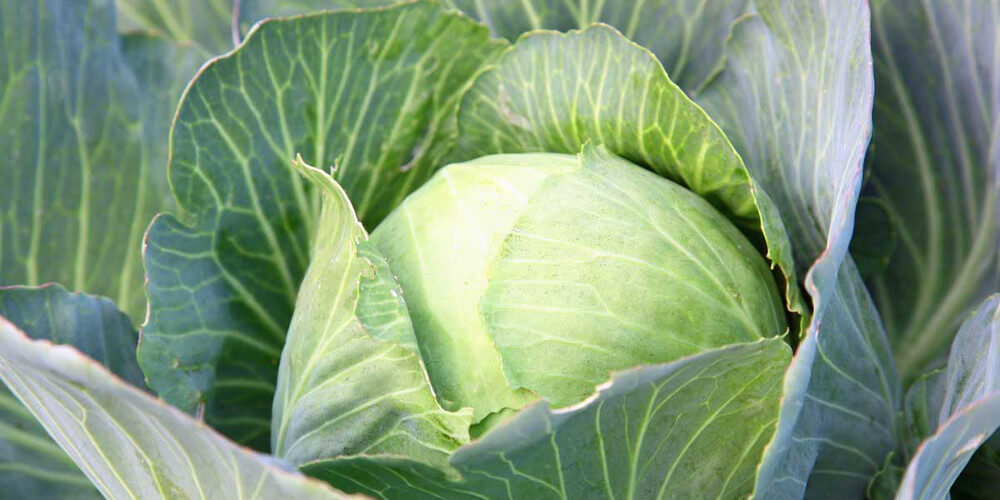Growing Cabbage
Posted On April 20, 2020

Traditionally, cabbage seeds were planted on St. Patrick’s Day in northern zones. Old-time farmers believed that to make them grow well, you needed to plant them while wearing your nightclothes! Here’s our Cabbage Growing Guide with instructions on how to plant and grow this hardy, leafy vegetable—which is packed with vitamins. No PJs required!
Follow our guide to plant a successful crop in the spring (and/or fall) and we’ll help you provide the diligent care that cabbage needs.
Planting
- Cabbage is a heavy feeder; it quickly depetes the soil of required nutrients.
- Prepare the soil in advance by mixing in aged manure and/or compost. Soil should be well-draining: roots that stand in water cause heads to split or rot.
- If starting seeds indoors, sow ¼ inch deep 6 to 8 weeks before the last spring frost.
- Before planting the seedlings outdoors, harden off the plants over the course of a week.
- Transplant small plants outdoors on a cloudy afternoon 2 to 3 weeks before the last spring frost date.
- Plant seedlings 12 to 24 inches apart in rows, depending on the size of head desired. The closer you plant, the smaller the cabbages.
- For a fall harvest, direct sow seeds outdoors (or plant transplants) in mid- to late summer. If your area is particularly hot and dry, hold off on planting until late summer. Make sure that the young plants don’t dry out in the summer sun’s heat!
Care
How to grow cabbages
-
- When seedlings reach about 5 inches tall, thin to leave the desired space between them. If you wish, transplant the thinned seedlings elsewhere.
- Mulch thickly around the area to retain moisture and regulate soil temperature. The optimum soil temperature for growth is 60 to 65° F. Young plants exposed to temperatures below 45°F for a period of time may bolt or form loose heads.
- Fertilize 2 weeks after transplanting with a balanced (10-10-10) fertilizer.
- Three weeks late, add a nitrogen-rich fertilizer; cabbage needs nitrogen in the early stages.
- Practice crop rotation with cabbages to avoid a buildup of soil-borne diseases.
Pests/Diseases
Some old folklore tells us: Scatter elder leaves over your cabbage to keep the bugs away.
- Aphids
- Cabbage Loopers
- Cabbage Root Maggots
- Imported Cabbageworms
- Clubroot
- Cutworms
- Flea Beetles
- Downy Mildew
- Slugs/Snails
- Stinkbugs
- Thrips
Harvest/Storage
How to harvest cabbages
- Harvest when heads reach desired size and are firm. Mature heads will split. This will take around 70 days for most green cabbage varieties. Most early varieties will produce 1- to 3-pound heads.
- To harvest, cut each cabbage head at its base with a sharp knife. Remove any yellow leaves (retain loose green leaves; they provide protection in storage) and immediately bring the head indoors or place it in shade. Alternatively, pull up the plant (roots and all) and hang it in a moist cellar that reaches near-freezing temperatures.
- To get two crops, cut the cabbage head out of the plant, leaving the outer leaves and root in the garden. The plant will send up new heads; pinch off those until only four or so smaller heads remain. Harvest when tennis ball-size (perfect for salads!).
- After harvesting, remove the entire stem and root system from the soil to prevent disease. Only compost healthy plants; destroy any with maggot infestation.
How to store cabbages
- Cabbage can be stored in the refrigerator for up to two weeks, wrapped lightly in plastic. Make sure it is dry before storing. In proper root cellar conditions, cabbage will keep for up to 3 months.
- Follow this old-time technique to get the most out of your cabbage crop:
- In the fall, harvest the entire cabbage plant—stems, head, and roots—enjoying the head as usual and storing the roots in a root cellar through winter.
- As soon as the ground has thawed in spring, plant the roots outdoors.
- Soon, fresh sprouts will form, which can be eaten alone or added to soups, salads, or a dish of your choice.
- These replanted cabbages won’t produce full heads, but they should go to seed by the end of summer, providing next year’s round of cabbage seeds!
-
- Note: This can also be done indoors on a windowsill in mid- to late winter; keep roots damp and sprouts should form.
Recommended Varieties
Cabbages comes in a range of sizes, shapes, and colors.
- For an early harvest, try ‘Primo’ or ‘Stonehead.’
- Quick-maturing ‘Golden Acre’ and ‘Quick Start’ yield 3-pound heads.
- For Savoy types, try ‘Alcosa’, an early variety, or ‘Wirosa’, a late variety that overwinters as-is in southern gardens but needs protection in the North.
- ‘Early Jersey Wakefield’ resists splitting. It’s an heirloom, slightly pointed, and 2- to 3-pound heads.
- Disease-resistant varieties include ‘Blue Vantage’ and ‘Cheers’.
- If you are planting for a fall harvest, try red or Chinese cabbage. Good varieties include ‘Integro’ and ‘Ruby Perfection’ (reds) and ‘Li Ren Choy’ (baby bok choy).
Website: www.almanac.com